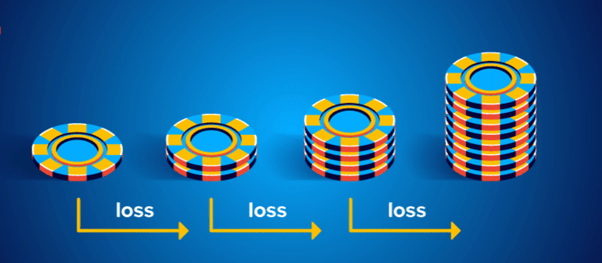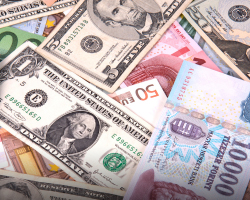Martingale Trading Strategy: High Profit or Uncontrolled Risk?

All novice traders are in search of the perfect strategy: simple, win-win, and not requiring a large initial investment. Some end up with the Martingale strategy, which is what we will talk about today. Is it as simple as it looks? Is it profitable for beginners or is bankruptcy more likely? Is it even worth applying it to the forex market?

What is the Martingale Strategy
The Martingale strategy came into the world of trading from the casino, namely from betting on roulette (red and black). The essence of the strategy was to double the bet after losing. Let's explain with an example: a player came to the casino with $ 7 in his pocket. He bet $1 on red - he lost; bet $2 on red - he lost; bet $4 on black - he won; he returned his bet of $4 and won $4, which paid off his previous losses. The player now has not $7, but $8. After winning, the bet goes back to the original $1.
According to probability theory, the chance of red or black on every roll will be 1/2, i.e. 50% - with equal probability either one or the other can fall out, regardless of the previous roll. That is, every time a player calls his bet, he wins with a 50% probability. That is why the Martingale strategy has shown itself so well in casinos - indeed, sooner or later you will get a win back.
In trading, the Martingale method works about the same way, only the bets are the lots in the bid. The trader predicts a fall in the price of asset A and opens a position for a 0.1 lot. The price continues to rise and the trader suffers the first loss. He now sells 0.2 lots of the same asset. The price does not drop in any way, and the trader puts 0.4 lot, and then 0.8. If the price finally collapses after placing a 0.8 lot, the trader makes a good enough profit on this trade to cover his previous drawdown.
The Way from Casino to Forex Trading
A surge of interest in risky methods appeared with the development of the fast financial market. The idea of a million-dollar jackpot haunts many beginners, especially those who consider the ability to play cards, such as poker, a guarantee of success in trading. And the "inspiring" mass culture actively forms the image of the stock exchange as a financial "casino".
It is considered that the Martingale system has an advantage on the financial market - we can analyze the market before opening the first trade, thus increasing the chances of success for a potential "chain" of orders.
The value of any stock can (theoretically) fall to zero, which is why few people are fond of Martingale on the stock market. The same cannot be said for currency assets, which always have a non-zero value even in times of crisis.
Forex is especially attractive for strategies with progressive growth of trade volume, for example, counting on a price pullback. In addition, you can make money on currencies by carry trade, as well as using technical methods to avoid losses.
In addition, the "pure" roulette math in trading is compounded by additional losses: as the volume of the trade increases, so do the costs of servicing it (spreads/swaps/commissions).
How long you will have to keep your orders open and how many more trades will be needed - no forecast will tell. Alas, the money in the Forex flies away from the account faster than in the case of similar bets in a regular casino.
How the Martingale Strategy Works in Forex
It would seem that how can you apply a strategy from the casino to Forex? But in practice, the Martingale method can be relatively successful (read: break-even) due to the property of prices to correct after an upswing or downswing. If you look closely at the chart of almost any asset, you will notice that small trends replace one another quite quickly. Traders who use the Martingale method trade mostly on corrections.
The Martingale logic as applied to forex trading is quite simple: if the price has fallen by 100 pips, then the breakeven trade will require a rise by the same hundred pips. And if you open one more order of the same kind, it will be enough to return 50 pips. The second order will give +50; the minus of the first order in this point will be the same 50 points, which makes the total zero. If the price after the second order still moves against the trader, after another 100 points a new entry is made according to the Martingale method, that is, with twice the volume.
Now the trader will need only 100 points to break even, not 200. At the same time, the loss will be 300 points instead of 200. The more unsuccessful orders are made, the faster the loss will grow. If the trader is lucky and the price finally follows his prediction, he may be in the black. If not, sooner or later the trader will run out of funds on the deposit and will have either to sit idly by and wait for the situation to improve, or close all of his orders, accepting the loss.
In order not to go broke using the Martingale method, you should open the first order so that you will have 8-10 unsuccessful trades in the future. That is, if you open the order for $10, you need to have on your account $10+20+40+80+160+320+640+1280=$2550. And it is the minimum!
Varieties of Martingale Strategies
The Martingale method can be used in different ways. Over the entire period of its existence several varieties of strategies have been developed:
Conservative Martingale. Instead of increasing the bet exactly twice, the trader increases the volume of trades by a smaller fraction, for example by 1/2. So, if the first bid was 0.2 lots, then the second will not be 0.4, but 0.3, then 0.45, and so on. The main advantage of this type of Martingale compared to the "classic" one is that there is no need for a huge deposit.
Averaging Martingale. The trader opens additional orders if the first one was unprofitable. Let's explain with an example: a trader bought 1 lot (i.e. 100,000 units) of EUR/USD at the price of 1.3000. The price fell to 1.2900, and the trader loses $1000. The trader buys another lot at 1.2900, thus averaging his entry price. If the price goes back up to 1.3000, the trader will win back his losses, because the profit from the second trade will be equal to the losses from the first trade. If the price continues to go against the trader, he will continue to average his orders - to open additional positions against the price movement. As soon as the price returns to its original position, the trader will repay unsuccessful trades. And if it rises even higher, he will make a profit.
Reverse (Anti) Martingale. The trader not only smoothly increases the volume of trades but also smoothly decreases it after the first successful trade. Usually, Reverse Martingale does not imply doubling of order volume but increasing it by 1 conventional step (e.g. 0.1 lot). Here is an example: trader opens a position for 0.1 lot, price continues to grow and trader bets 0.2, 0.3, 0.4 lots. Then the price starts to fall and the trader gets a profit. Instead of opening the next order for a 0.1 lot, the trader opens an order for a 0.3 lot. If it turns out to be a loser, the trader goes back to increasing volumes.
Disadvantages of the Martingale Strategy
Despite its popularity among beginners, the Martingale method has a lot of opponents in both stock and forex markets, and their arguments are quite reasonable. Obviously, a strategy that comes from the casino world will not be ideal under market conditions. So, let us list the main disadvantages of Martingale:
Betting on doubling raises very quickly, and the trader needs a huge deposit. Recall our example of $1, $2, $4... Increasing the stakes doesn't seem scary? But in the market, you will work with completely different numbers. Here, trades of 1000, 2000, 4000, and 8000 dollars are more likely. What if the first four trades turn out to be unsuccessful? Will you have another $16000 to make a new double bet? To work successfully with the Martingale strategy, you must either start with very small amounts (and get corresponding profit) or have a huge deposit. Of course, you can use the leverage, but this tool is very dangerous for beginners - with it it is even easier to lose your deposit than without it.
A trader needs iron nerves to keep sticking to the strategy. Martingale is a strategy popular with novice traders. But in the process of working with it, beginners can begin to understand the market and make their predictions - no wonder they have a desire to move away from Martingale and place an order that seems more profitable to them. But by abandoning the Martingale strategy right in the middle of a series of failures, you lose quite a large amount of your capital.
Martingale is grounded in a casino where winnings are calculated on the bet amount at a fixed rate, and winning depends on pure luck. For example, betting $5 on red, you are equally likely to either lose that money or double it. It doesn't work that way on the stock market or forex - you can't calculate an exact profit (or loss) from a trade. And that means that the final winning trade may not cover all the losses of the previous losing streak (not to mention that it may not take place at all).
Traders who adhere to the Martingale method often ignore the technical analysis of the market and try to make money "on pure luck". Martingale tempts the trader to give up one of the most powerful tools on the market - analytics. First, it can lead to heavy losses; second, it simply slows down the trader's professional development. It takes an iron endurance to trade by Martingale and to continue learning.
Secrets of the Martingale Strategy
Martingale in Forex can work well only with very volatile currency pairs. If quotes tend to rise or fall without significant corrections for several days in a row, the Martingale may not work - the streak of unsuccessful orders will be too long, and your capital will not be enough to open the last orders. Such, for example, is the currency pair GBP/JPY that likes a no-failure trend of several hundred pips. Choose assets whose charts are less linear and more like waves - Martingale works better with them.
And now let's reveal another little secret - most traders who work with the Martingale method do not do anything manually. This strategy is rather poorly connected with market analysis (both technical and fundamental), and therefore a robot can do most of the work quite well. To use the strategy, traders configure the trading terminal for automatic orders according to a certain algorithm. Automatic orders in the trading terminal can catch trends and corrections, and then open orders according to the pre-set. If the asset and the algorithm are chosen correctly, this approach will help to generate almost passive income.
Successful traders apply Martingale only on a part of their deposit rarely exceeding 1/5. From this, we can conclude that the Martingale method is suitable for traders with huge capital because even 1/5 of it allows them to trade effectively using this strategy. In this case, the Martingale is regarded by them as a weak passive income, while the active trading according to other strategies brings much more money.
Automation of the Martingale Method in Forex
In forex trading, more often other ratios are used than doubling of bets. For example, to give strength to a deposit as a whole, a trader can use odds 1.5, 1.2, and so on. Thus, each subsequent trade will be opened with a volume equal to the volume of the previous trade multiplied by the selected coefficient.
Let us list the reasons why the martingale system may seem attractive to novice traders:
- losses are not fixed (the trading capital either gradually grows or is lost),
- trading is possible in fully automatic mode.
The peculiarity of the use is to close trades simultaneously when their sum will be above zero. The loss, which in roulette appears at once, when a different color than the player chose, in forex accumulates on all trades, which are opened again and again, waiting for the price reversal in the opposite direction.
Such simplicity of calculations allows for automating the trading process, which traders have tried to use in their work. Now among all varieties of forex advisors, the robots based on the strategy under consideration are probably the most popular among speculators, especially among beginners. As an example, let us consider a variant with doubling the lot for each new position. We will take a fixed distance between two successive trades.
In this case, if the price goes against the first position with a volume of 1 lot and passes 30 points, then the second position will be opened. The volume of the second position will be 2 lots, the direction should coincide with the direction of the first order. That is if at first there was a buy with one lot, then further will be the same buy, only with two lots.
If necessary after 30 points there will be a position with a volume of 4 lots, then with 8 lots, and so on. All positions should be closed when the sum of all of them will be positive. This example shows the whole essence of the Martingale system.
So, how to set up Martingale Expert Advisor?
First of all, be sure to check if your broker allows the use of Martingale and locking positions (in any form) - there are options when they "catch" on the dynamics of orders and block accounts.
Using swap-free accounts in such schemes would significantly reduce swap losses.
Let us note only mandatory parameters that should be available for fine-tuning of any Expert Advisor:
- Lot multiplier (lot exponent, replicator, multilot): a coefficient to increase the volume of the next trade. Increasing this parameter reduces the range to the total Take Profit when the Expert Advisor closes the entire order grid. Decreasing the parameter increases the number and period of all trades. The parameter should be adjusted for the current volatility. Recommended: 0.5-2.
- A maximum number of steps (levels, orders): If the value is too low, the Expert Advisor will not be able to open the next, possibly, profitable order and it will close the grid with a loss. Increasing the parameter increases the load on your deposit. Recommended: 3-10.
- Distance (step) between orders: a small step will open many trades with small profit and is recommended for scalping. A larger number is necessary for mid-term strategies or weakly volatile assets.
- Take Profit size: this is determined by your overall strategy.
Minimizing Risks of Martingale
First off, you need a known profitable strategy in which you can use individual elements. Which one you choose is up to you, but let's assume that you already have it and have plenty of leverage. Some basic rules:
- trade only with Stop Loss, limiting a large loss;
- check the number of negative trades in the history of the chosen strategy, going in a row. It is important to find not the maximum, but the average value of this parameter. For example, if we are talking about the M5 time frame, the testing time is 1-2 months, for D1 - testing is 1-2 years.
Strategies can be tested with utilities, of which there are many on the Internet. Once the number of consecutive negative trades is calculated on the history, the so-called "knee" is introduced into the strategy - orders with an increased lot, which correspond to this number. For example, if your strategy has 3 losing trades, then the number of "knees" will also be 3.
Practical Example. Let's assume that the Stop Loss is equal to 10 pips, a Take Profit order is equal to 20 pips, and the average number of losing trades is 3. The price starts to move upwards, you decide to open a short position for a 0.1 lot.
The price continues to move upwards and triggers a Stop Loss, the loss of the operation amounted to 10 pips. The price continues to move up, you get a sell signal (that is, you assume the price is about to turn down). Then you open a short position again, but with a larger lot. And here's the tricky part: it is believed that you have to double the lot, but that's not true. You can increase the lot by 10% or three times. In this case, we increase it only by 50%.
Once again, we incurred a loss as the price has not reversed and the position has closed at the Stop Loss. The loss has amounted to 10 pips again, but already at 0.15 lot. We are not discouraged and wait for the signal to sell. And here it appears. We place the sell order again with an increase in the lot by 50%.
And now, for the third time, we are lucky, and Take Profit of 20 points has triggered.
Suppose we had worked with 0.1 lot all the time, what would have happened as a result? In the first position, we would have made a loss of $10. In the second position, we would have made a loss of $10, in the second position we would have made a similar loss, and in the third position, we would have made a profit of $20. In the third position, we would make a profit of $20 and break even. In our case, we made a loss of $25 in two positions and $50 in the third position. In the second position, we would have made a loss of $40, and in the third position, we would have made a net profit of $15. In our case, we lost $25 in the third position and made a profit of $15. But what would happen if the third position turned out to be unprofitable? Remember, above we started with the notional number "3 losing trades in a row?" That means we can increase the lot three times. If the 4th trade after the 3rd one is again losing, we face an irregular market situation and we need to urgently limit the risks. If you continue to thoughtlessly increase the lot in a non-standard situation, there is a risk of losing the deposit. That is why in this case it makes sense to go back to 0,1 or 0,15 lot until the strategy comes back to its normal course.
Another rule of thumb: you should not be tied to buying or selling. For example, the price goes up, closes our short position on the stop, and then there is a signal for a confident continuation of the uptrend. So why not take advantage of it? We open a long position with 0.15 lot. And if the price suddenly moves downwards (a false signal), we open a short position with 0.2 lot.
Strictly adhere to the rule of risk management - the largest lot should not exceed 10% of the deposit!
This strategy quite works in conjunction with trading advisors. The main entry point (the very first one) is located and opened manually, while the Expert Advisor will automatically increase the lot and automatically open additional trades.
Conclusion
Martingale is a psychologically difficult tactic, it is not suitable for everyone, which saves many deposits from a rapid loss. For example, when you have already fallen into such a "trap", but the market gives you a chance and has already compensated 50-70% of potential losses, then close a series of trades and start your life over again.
Rest assured, the market is not aware of your problems and it is always better to accept a few failures than to keep losing. Even if you have a successful experience with Martingale - do not take the situation to a catastrophe, this way you will save money, nerves, and faith in yourself.









